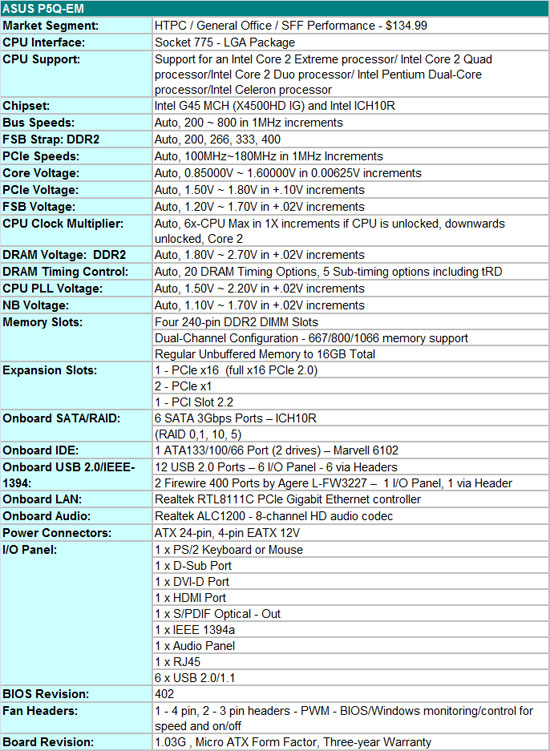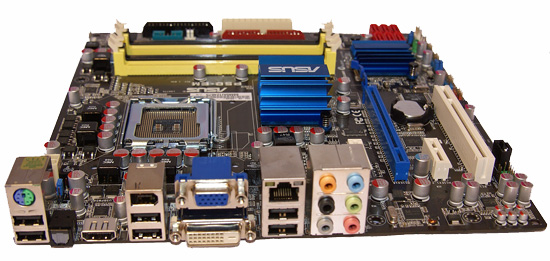The IGP Chronicles Part 1: Intel's G45 & Motherboard Roundup
by Anand Lal Shimpi & Gary Key on September 24, 2008 12:00 PM EST- Posted in
- Motherboards
ASUS P5Q-EM
Our first board up is the ASUS P5Q-EM, which is a worthy successor to the G35 based P5E-VM HDMI. In addition to being the first board that we discuss today, it also happens to be our favorite “all around” board. All four of our boards perform almost identically when it comes to high-definition playback and they all score similarly in our IG based tests. However, if you want a uATX board for your SFF gaming system or plan on overclocking then the ASUS board is a logical choice. Of course, our uATX P45 based DFI P45-T2RS Jr might disagree, but that is a discussion for another time.

In the meantime, the P5Q-EM is a feature rich G45 board featuring an OC friendly BIOS, Gigabit LAN via the almost universal Realtek RTL8111C, IEEE 1394a support, full RAID support along with six SATA ports via the ICH10R, PATA support comes by way of the Marvell 6102, and HD audio via the Realtek ALC1200. Think of the ALC1200 as being the same chipset used by Gigabyte this past year, the ALC889a. However, ASUS does not provide DTS Live and Dolby Home Theater capabilities that Gigabyte does although we understand ASUS is working with DTS on an upgrade. However, one of the main attributes for purchasing a G45 based board is for the multi-channel LPCM output capabilities.
ASUS also provides their Express Gate technology that allows you to access the internet or utilize the most popular IM programs without booting into the OS. Also featured is their EPU-4 engine that provides additional power savings by detecting load conditions and adjusting power in real time. We will have a dedicated look at ASUS' EPU, DES from Gigabyte, and DrMOS from MSI shortly. In the meantime, we were able to save a few watts at various times over the traditional C1E/Speedstep BIOS settings. Fan control and monitoring is good with the capability to set fan speeds based upon thermal conditions in the BIOS or Windows.

In our opinion, ASUS provided an excellent layout considering the space limitations on a Micro ATX board. If the board is utilized in a SFF gaming system, the user is still left with a free PCIe x1 and PCI slot when using a dual slot video card. The heatsink designs did not interfere with a variety of peripherals that we installed including several popular CPU fan/heatsinks and video cards. We have noticed the G45 MCH running a little hot at times but the heatsink design from ASUS was more than capable during testing. We are still waiting for the official death of the floppy drive (and soon the IDE port but we still see value in IDE for a little longer) so the area where these connectors are located can be reclaimed.
ASUS utilizes an excellent four-phase power delivery system along with decent solid capacitors throughout the board that resulted in very stable operation with everything from a Q9650 down to a heavily overclocked E2180. The inclusion of a PS/2 combo port for either a keyboard or mouse is a nice touch for now as we see most suppliers dropping PS/2 support shortly. Other niceties included output support for VGA, HDMI, or DVI-D along with a Firewire port on the IO panel. Overall, the layout is clean, unobtrusive, and will work well for a vast majority of owners.
Pros/Cons
We have to be honest here, up until BIOS 0402, we were not that enamored with this board from an enthusiast's viewpoint. Sure, the basic functionality was there and all peripherals worked fine for a HTPC setup, but the board was not living up to its BIOS options. While this is not important for the vast majority of users looking at IG boards, it is important for users who will use this board as a crossover for a performance oriented SFF system. Our problems ranged from lack of support for the E8600 and Q8200 processors to 8GB compatibility under Vista 64. Additional problems were incurred when overclocking the system as we consistently hit a wall around 415FSB with a 4GB configuration and VCore tended to undervolt severely when set above 1.45V, although with the newer EO steppings you should not have a need for volts that high. Fortunately, most of our performance problems have been solved including overlcocking with memory ratios other than 1:1.
While still not perfect, we were able to attain 455FSB with our Q9300 and 485FSB with the E8600 with aggressive timings, a discreet video card, and 4GB. We are not going to show in-depth overclocking results in today's article since it is oriented towards the chipset introduction with intended use for an office or media application platform. However, if you need an uATX board that offers very good overclocking performance for mainstream users, this board will not disappoint with a discreet video card. We hit a 412FSB wall with the integrated graphics set, not bad at all actually. While video performance is not improved, it is a good way to improve encoding performance with a lower speed processor.
Moving on to more important items for most of us, except for driver, strict EDID adherances, and BD playback problems that are the responsibility of Intel, this board performed admirably throughout IG testing. In our particular setups, we did not have any real problems except for 8GB compatibility under Vista 64 up until BIOS 0402. That said, we think ASUS made a mistake not including an eSATA port on the IO panel. We are also not fans of VGA output or continuing with floppy drive support in this market segment. Both choices would likely be viable options for certain business environments, but we do not see their usefulness in this particular target market. The board worked perfectly when resuming from an S3 state and consistently outperformed the other boards in time to desktop measurements.
While we like the combo PS/2 mouse/keyboard port since it is better than none (yes, we still like the PS/2 keyboard port when overclocking or changing BIOS settings), users with certain wireless keyboard/mouse setups will have to think about upgrading. In fact, PS/2 port availability is something we openly debate, some openly love their inclusion, and some of us just wish we would finally get rid of the legacy ports. We would not have minded a coaxial SPDIF port or IR capability either. Overall, the feature set is impressive for a uATX board and if we only had one wish, it would be adding an eSATA port to the rear IO panel. To reiterate our opinion about this board, if you need a uATX board with versatility then we think this is the board for you.















53 Comments
View All Comments
kilkennycat - Wednesday, September 24, 2008 - link
Anand and Gary,Seems as if an important candidate is MIA in your 3-part review of integrated chip-sets/uATX motherboards, the LONG-promised nVidia MCP7A chip-set for Intel processors with integrated 9400/9300 graphics. The only potential integrated-graphics competitor to the G45 in the Intel-processor world. When is the MCP7A due to be released? Most recent speculation (in DigiTimes, iirc) was the end of this month (September). In time to add a review of one or more uATX motherboards based on this chipset as Part 4 to this group of three reviews?
Anand Lal Shimpi - Wednesday, September 24, 2008 - link
By the time this series is over the MCP7A won't be out, but we'll have a standalone review of that product to coincide with availability :)-A
yehuda - Thursday, September 25, 2008 - link
Ok, when will this series be over? I ask because the last news on MCP7A said that it should be out before the end of this month and your statement makes me wonder if there's another delay ahead.kilkennycat - Wednesday, September 24, 2008 - link
Anand, thanks for the reply.NDA gag on projected-availability information from nVidia ??
Anand Lal Shimpi - Wednesday, September 24, 2008 - link
Yep, it won't be too much longer and NV is quite excited about it but specifics I can't give out unfortunately.*If* I were in NVIDIA's shoes I'd want to capitalize as best as possible on Intel's handling of G45. I'd make sure that the first products worked *perfectly* and availability was immediate and at competitive prices.
If NVIDIA blows this opportunity I'll be quite disappointed, especially given how much crap it has given Intel about Larrabee.
We'll know soon enough, but after the IGP Chronicles are over :)
-A
Pederv - Wednesday, September 24, 2008 - link
From what I read, the G45 can be summed as, "It has a few good points but over all it sucks."kevinkreiser - Wednesday, September 24, 2008 - link
I was hoping there would be mention of the graphics problems when putting nvidia cards in these boards. I was very vocal about this over at the AVS forums. Did any one notice any mention of this in the article? Also will there be coverage of the new nvidia boards MCP7A?Gary Key - Wednesday, September 24, 2008 - link
Our final article will feature the discrete cards like the 9600GT and HD 4670. In testing so far, I have not had the problems that have been reported. I do have some additional NV cards coming to test. We will have coverage on the GeForce 9400 series when it launches. ;)kevinkreiser - Wednesday, September 24, 2008 - link
Thanks for the quick reply. I appreciate you guys keeping an eye out for the aforementioned problem. And also thanks for the heads up on the forthcoming MCP7A article.sprockkets - Wednesday, September 24, 2008 - link
http://www.newegg.com/Product/Product.aspx?Item=N8...">http://www.newegg.com/Product/Product.aspx?Item=N8...Shame it costs $100 though. Shame too that Intel boards work so poorly, since I like that mini-itx board. The one from Jetway for the 8200 chipset probably doesn't work any better.